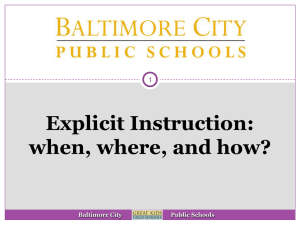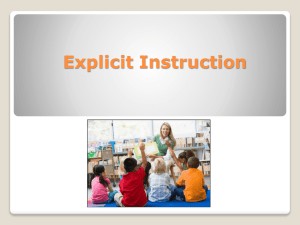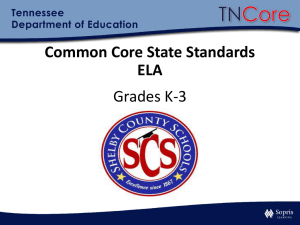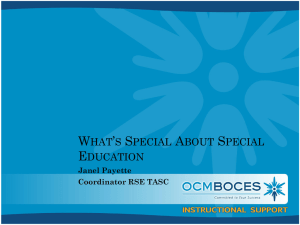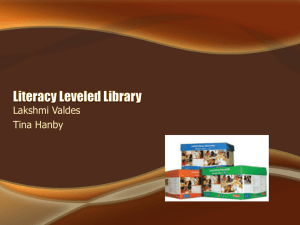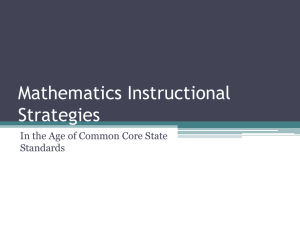Presented by Karen L. Moore, Ed.S.
advertisement
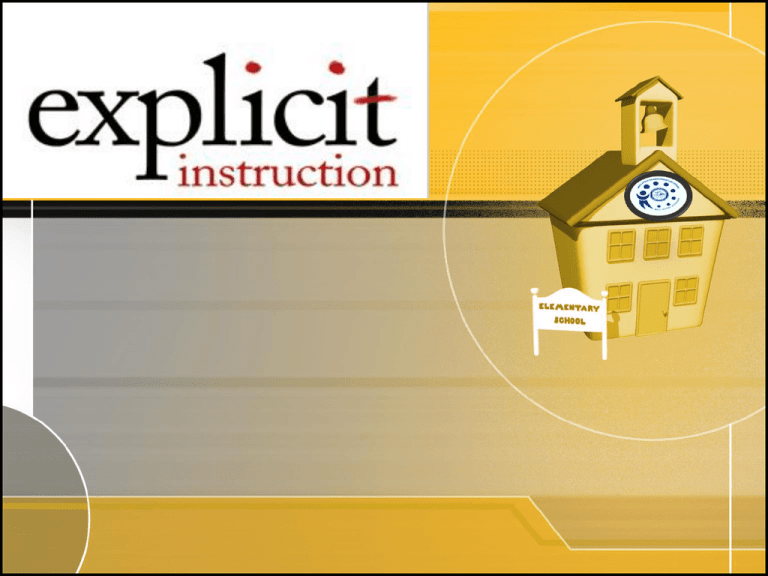
Common Board Configuration (CBC) DATE: June 10, 2013 BELL RINGER: “Do’s and Won’ts” VOCABULARY: introduction; guided practice; collaborative practice; independent practice; scaffolding; recursive; modeling; think-aloud; gradual release of responsibility; progress monitoring; corrective feedback AGENDA: OBJECTIVE: To provide information on how to plan and conduct lessons on which literacy skills are explained, demonstrated, and taught using explicit instruction. BENCHMARK: Demonstrate an understanding of the elements of explicit instruction . ESSENTIAL QUESTION: How can the consistent use of systematic explicit instructional techniques enhance students’ learning? EXIT SLIP: 3-2-1 1. List three things that explicit instruction is. 2. List two things that explicit instruction is not. 3. List the one component of explicit instruction that you still have questions about. HIGHER ORDER QUESTIONS: • How will I ensure that teachers successfully incorporate collaborative strategies during group work? HOME LEARNING: Utilizing the ELA Common Core Standards for your grade level, develop an explicit lesson. “Do’s and Won’ts” List two best practices and/or instructional strategies that were effective this year. Briefly explain. List one practice and/or instructional strategy that was ineffective this year. Briefly explain. Objectives At the end of this training session, you will be able to: 1. state a definition of explicit instruction 2. list the components of explicit instruction 3. provide examples for each of the components “Tell me and I forget. Teach me and I remember. Involve me and I learn.” –Benjamin Franklin Explicit Instruction: Why Embrace It? • Research supports that explicit instruction is more effective and efficient, especially for struggling students, including those with disabilities • Explicit instruction is instruction that does not leave anything to chance, and it does not make assumptions about skills and knowledge that children will acquire “on their own.” • Through explicit and systematic teaching, teachers can actually help “rewire” the brains of struggling readers and help them overcome reading problems. Chall, The Academic Challenge: What Really Works in the Classroom Activity Read Like a Detective! • Read the Sixteen Elements of Explicit Instruction. • With your table group, select the elements that are directly related to the component you were assigned (Planning, I Do, etc.). • After a brief discussion, use the attached worksheet to record its’ instructional impact on teaching and learning; describe what your component looks and sounds like in action. Explicit Instruction = Effective Instruction Explicit: • an unambiguous and direct approach that supports or scaffolds learning Effective: • research based proven strategies – Design and Delivery Components Efficient: • maximizes learning in the shortest amount of time Essential Components to EI Appropriate Pacing Frequent Student Responses Provide Adequate Processing Time Instructional Delivery Components (Hall, 2002) Monitor Responses Corrective Feedback Let’s Think About It… • When students actively participate in their learning, they achieve greater success. • The teacher must elicit student responses several times per minute, for example ask students to say, write, or do something. Highly interactive instructional procedures keep students actively engaged, provide students with adequate practice, and help them achieve greater success. Frequent Student Responses Let’s Think About It… • The pace of instruction is influenced by many variables such as task complexity or difficulty, relative newness of the task, and individual student differences. • When tasks are presented at a brisk pace, three benefits to instruction are accomplished: (a) students are provided with more information, (b) students are engaged in the instructional activity, and (c) behavior problems are minimized (students stay on‐task when instruction is appropriately paced). Appropriate Pacing Let’s Think About It… • Think time (adequate processing time) is the amount of time between the moment a task is presented and when the learner is asked to respond. • Time to pause and think should vary based on the difficulty of the task relative to the student(s). If a task is relatively new, the amount of time allocated to think and formulate a response should be greater than that of a task that is familiar and in the learners' repertoire. Provide Adequate Processing Time Let’s Think About It… • This is an essential teacher skill to ensure that all learners are mastering the skills the teacher is presenting. Watching and listening to student responses provides the teacher with key instructional information. • Adjustments may be made during instruction. Teachers should be constantly scanning the classroom as students respond in any mode. Monitor Responses Let’s Think About It… • Students should receive immediate feedback to both correct and incorrect responses. • Corrective feedback needs to be instructional and not accommodating. • Feedback to reinforce correct responses should be specific. Feedback should not interfere with the timing of the next question/response interaction of the teacher and student. • Feedback that does not meet these criteria can interrupt the instructional episode and disrupt the learner's ability to recall. Corrective Feedback Effective Instruction Steps Corrective feedback Independent practice Guided practice Modeling/demonstration Explanations and directions Opening instructional routine Learning objective (Carnine, 1997) Implementing Lessons with EI Phase 1: Introduction and Review – Students are drawn into the lesson – Teacher attracts students’ attention – Teacher activates background knowledge through a thorough review of prerequisite knowledge or skills Implementing Lessons with EI Phase 2: I DO (Modeled Instruction) – New content is presented and explained – Teacher begins schema production by explaining and illustrating the concept or thinking aloud and modeling the skill being taught – Teacher promotes involvement by modeling, providing examples, and actively questioning students to guide their understanding Implementing Lessons with EI Phase 3 Guided Practice (We Do /They Do) – Students practice the concept or skill under the teacher’s guidance with high levels of interaction – Teacher helps students develop perceptions of competence – Teacher ensures success – Teacher monitors progress – Role of teacher changes. Teacher moves from information provider and modeler to COACH, withdrawing instructional support as students master skill. Increasing Motivation with EI The guided practice of EI develops perceptions of competence. Perception of competence is highly motivating. As students become more competent in using the concept or skill, they equate their hard work with success. Implementing Lessons with EI Phase 4 Independent Practice (You Do) – Students practice using the concept or skill on their own – Students develop automaticity – Students develop the ability to transfer their understanding to new contexts – Two stages: (1) students practice on their own under teacher supervision and (2) students work completely on their own Activity A Lesson Delivery Student Engagement Video Planning for an Explicit Lesson Planning for an Explicit Lesson Planning for an Explicit Lesson ETO Template Discuss the process aloud as you are doing it. “This is what I do first, next, etc….. • Direct Definition and reason this is an important skill. I will show you how to… This is how I remember what I'm reading… • Today we are going to learn about… This is what I thought… • The reason we are going to learn about… I say to myself… • This is important because… Do you see how I talk to myself as I read? • The strategy we are going to learn about is called: I knew right here (point to text) that… This means: As I was reading I realized… • By the end of the lesson, you will be able to… As I was reading I wondered… Now that I've read, I realize… Now that I've read, I understand… The secret to this is… Before you read on your own, let me show you how I… ETO Template • How can students practice (e.g., teacher/students, students/students) the concept while the teacher monitors their understanding? • Now let’s practice together, remember I did it like this, you try it, what was the next step…… • We will read this together and I expect you to… • Students practice together and engage in student accountable talk ETO Template Now you do it and I will watch you, remember the steps we used to……. While the students are doing this circulate and immediately give feedback and correct mistakes. VERY IMPORTANT: Make the relevant connections. Discuss why this is an important skill. Why do they need to know it and where they might apply this skill. • List three things that explicit instruction is. • List two things that explicit instruction is not. • List the one component of explicit instruction that you still have questions about. HOME LEARNING Utilizing the ELA CCSS for your grade level, develop an explicit lesson. Thank You! Mrs. Karen L. Moore, Ed.S. klmoore@dadeschools.net Ms. Darlene Diaz darlenediaz@dadeschools.net


